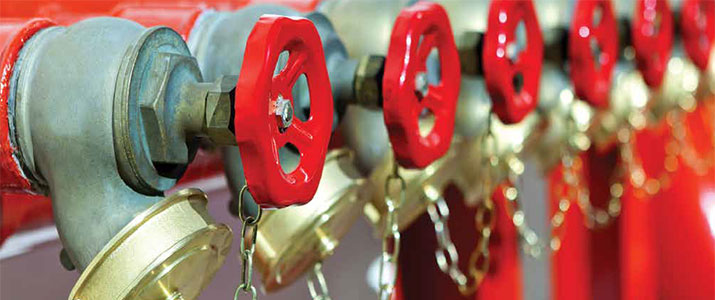
Pumping Up Fire Protection
Plant’s communication and intelligibility issues solved
- By Brian Carlson
- Aug 01, 2013
 The Grundfos-Indianapolis manufacturing facility in Indiana, a plant
that produces a broad selection of water pumping equipment, much
of which results in small to large fire pump systems for commercial
facilities, was in need of a fire alarm upgrade.
The Grundfos-Indianapolis manufacturing facility in Indiana, a plant
that produces a broad selection of water pumping equipment, much
of which results in small to large fire pump systems for commercial
facilities, was in need of a fire alarm upgrade.
Initially, the plant intended to get a code-compliant, addressable
fire alarm system with horns and strobes for notification capable of covering the
site’s 300,000 square-feet of offices and manufacturing space. However, following
a demonstration of a Gamewell-FCI E3 Series fire alarm and voice evacuation system,
given by local fire and security integrator USAutomatic, the factory decided
to undertake a more comprehensive life safety upgrade.
“First and foremost, we needed a better monitoring system,” said Mike Garland,
environmental, health and safety manager at Grundfos-Indianapolis. “But once we
discovered this E3 [Series] technology, we figured, ‘why not add on the voice evacuation
system’ as we did not have an adequate notification system in place. Plus, we
liked the fact we could use the new system for adverse weather alerts.”
Grundfos-Indianapolis wanted a fully-supervised fire alarm with the capability
to broadcast live and pre-recorded messages, but the ambient noise throughout
this mainly-industrial facility posed a challenge to the intelligibility of those communications.
Moreover, the system had to be easy to use, monitor and economically
accommodate future facility expansions.
Industrial Intelligibility
When USAutomatic was initially consulted, company Vice President Brent Agan and
his team performed a walk-through of the plant to evaluate its existing equipment.
“The intelligibility of the notification throughout their plant was poor, and we
quickly assessed that the existing speakers were inadequate,” Agan said.
To distribute power from the E3 Series’ digital voice system, Agan’s team selected
six AA-100, bulk audio amplifiers (70.7rms) capable of supplying up to
100 watts of power to approximately 63 supervised horn loudspeakers equipped
with a highly-efficient compression driver, providing up to 15 watts of power per
speaker. This bulk audio package enabled the complete installation to be done using
only eight circuits with approximately eight speakers per circuit to assist with
minimized disruption to plant activity and a reduction of installation costs. Each
speaker tapped between 1.8 to 7.5 watts, and USAutomatic centralized the bulk
audio amplifiers in a convenient location for ease of access, service and inspection
“For large, open spaces, such as the Grundfos-Indianapolis factory, the E3 Series’
digital voice capabilities, combined with the proper selection and placement
of horn loudspeakers with ample power, can deliver a level of communication
intelligibility far exceeding any customers’ expectations,” Agan said.
Notification for the facility offices involved the installation of 86 strobes and
horns, plus 25 additional speakers and strobes throughout. Two horn loudspeakers
were installed outside and away from the building in employee gathering sites
to ensure all emergency notifications could be heard and understood.
“With the outside speakers, we can now let people know when an emergency
situation has cleared, and they can return to their workstations,” Garland said.
“We didn’t have that capability before.”
When it came to fine-tuning the audio intelligibility, Agan said, “With some
help from the Grundfos-Indianapolis staff, we walked the facility with a decibel
meter and recorded ambient noise throughout the facility. We then plotted those
results on a drawing and ultimately designed the speaker system to make sure we covered all areas adequately. The result
was a highly-intelligible system in an
increased ambient noise environment
due to the manufacturing activities taking
place.”
Before voice evacuation and mass
notification systems became popular,
the fire alarm industry had a different
design focus than acoustic systems designers
or public address and music systems.
When the 2010 edition of NFPA
72: National Fire Alarm and Signaling
Code expanded its coverage of emergency
communication systems (ECS),
which included new intelligibility requirements
for fire alarm voice evacuation
and ECS, the industry’s focus on
proper system design and testing for
intelligibility changed.
Signal-to-noise ratio is a comparison
of the volume that is being produced
by a speaker to the ambient or
background noise in a space. Chapter
18 of NFPA 72 calls for the speaker
sound output to be an average of 15
decibels (dB) higher than ambient to
achieve the needed intelligibility. Any
higher than 15dB over ambient will
most likely diminish the level of intelligibility;
therefore, it is recommended
that more speakers be added at lower
tap settings as opposed to increasing
existing speakers’ sound output.
Proper layout and placement of
speakers is another factor that greatly affects
intelligibility, particularly in large,
open spaces with high ambient noise.
Commercially-available software programs
can be used to simplify the design
of intelligible voice evacuation systems.
Sound designers use these programs
to model the acoustical properties of
specific environments and speaker configurations.
With proper speaker, space
and room layout information, these programs
can help predict the intelligibility
of a voice system before installation.
Expandable Networking
The modular design of the E3 Series
allows each system to be scalable to
provide a custom fit that can be easily
expanded or reconfigured over time, extending
the system’s lifecycle.
The plant’s current system can support
up to 64 nodes, and adding an expander
board can double the capacity
of that single fire alarm control panel.
Using a twisted pair of copper wires or
fiber optic cable to network all major
components makes expansions and retrofits
easy and more economical.
“The E3, in my view, is one of the
strongest building blocks of emergency
voice evacuation in that we can continue
to add and expand using modules,
which makes installation cheaper and
easy,” Agan said. “The device is complex,
but the componentry is simple
and easy to expand.”
Use of the System
“This project does a great job of showcasing
the E3’s emergency voice capabilities,”
said Agan.
Prone to severe weather during the
spring tornado season, the Indianapolis
plant recently broke in its new notification
system to instruct employees to
take shelter during a dangerous storm.
“We recently had a severe thunderstorm,
which caused a phase reversal
fault in a fire pump, and the [fire alarm
control] panel pulled that right up, significantly
reducing our troubleshooting
efforts,” said Todd Walterman, environmental,
health and safety coordinator
for the company.
Garland’s staff specifically appreciates
the system’s battery back-up, which was
lacking in their former communications
system. The site recently experienced a
power outage and for the first time during
such an event, the facility’s staff was
able to communicate with employees to
convey appropriate instructions.
The new fire alarm also monitors
the plant’s new sprinkler system installed
by USAutomatic, in addition
to the existing suppression system that
runs on a pump produced by Grundfos-
Indianapolis.
“Grundfos-Indianapolis has been
generous in allowing us to invite other
end users to witness their monthly testing
to see what the system can do,”
complimented Agan.
Experience Counts
While the E3 Series system was easy to
work with, Agan’s crew did have to contend
with executing the installation in a
busy, ongoing industrial environment.
“The logistics of having access to
all areas required a high degree of coordination
with floor production and
the EH&S department,” Agan said.
“Some equipment could not be moved,
so we had to have boom lift equipment
to be able to operate in those areas.
While installing wire wasn’t difficult,
sometimes getting to the spot was
challenging.”
Ultimately, due to its size and high level
of intelligibility, the plant has become
a flagship installation for USAutomatic.
“Overall, it was just a great system
for us to put in here,” Garland
said. “I wanted a system that I was
very comfortable with, and I’m very
pleased with what we
got. I think it’s a great
product.”
This article originally appeared in the August 2013 issue of Security Today.